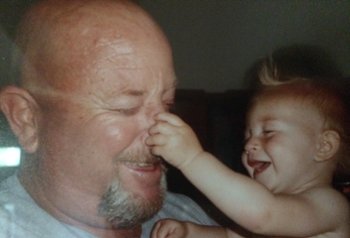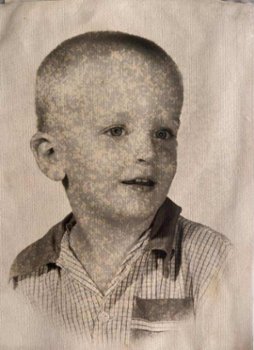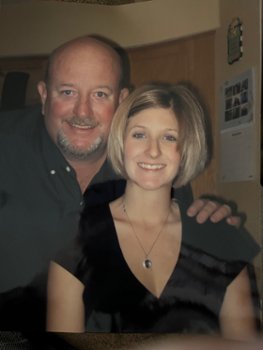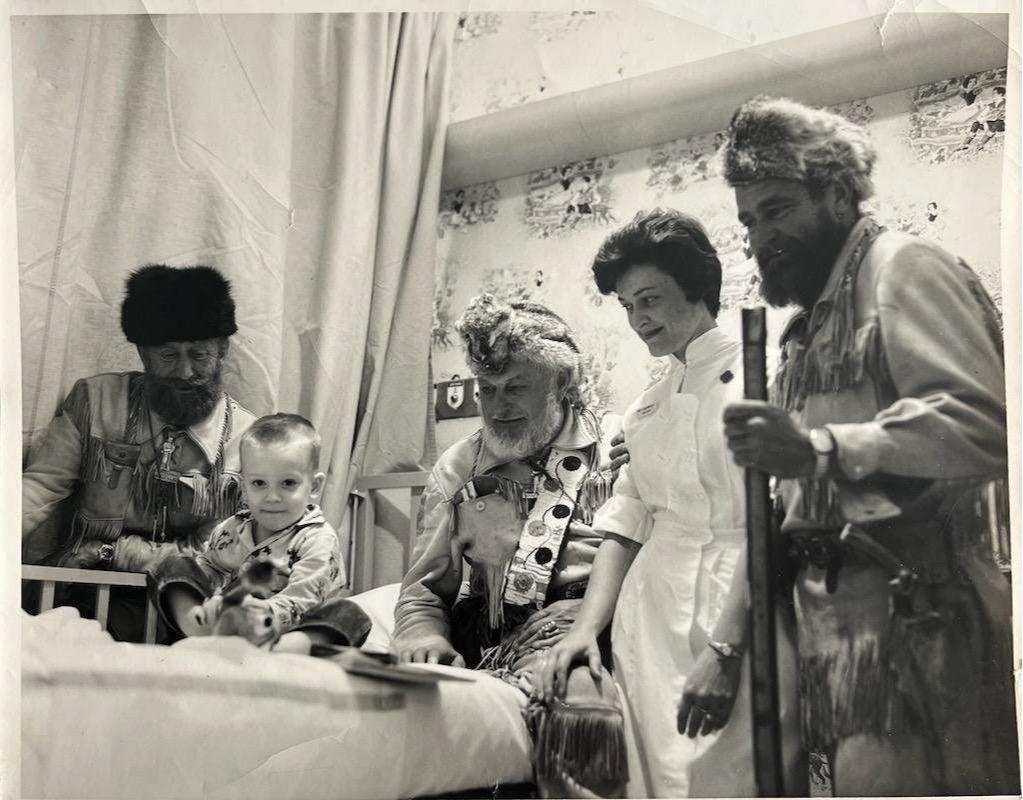The Tin Man
Generations of Impact from One Man’s Unique Life
By Jenn Venerable - December 15, 2023
Photos provided by Staci Terrin.
William (Bill) Toon, Jr. was 53 years old when he passed on September 5, 2013. He grew up in Arizona. Bill really enjoyed hunting and camping. He was a civil engineer, and he loved his work, but he loved his wife Cindy and their three grandkids even more and spent as much time as he could with them.

Bill and his grandchild, Summer.
While this summary could describe many people, Bill was unique for his life experience and especially the impact that experience had on others.
Bill was one of the first pediatric patients to receive an artificial heart valve when he was four years old. He was diagnosed with Tetralogy of Fallot, a birth defect that affects blood flow through the heart, and the Shriners raised money and paid for his surgery. Living with this condition made him more willing to talk about death and his desires than most. In death, he was able to be a cornea donor and touch the lives of two strangers, but his life and death had a lasting impact on his daughter, Staci Terrin — currently the Technical Manager at the Rocky Mountain Lions Eye Bank — and her professional life in eye banking as well.

Bill as a child.
SNMAN
Bill’s license plate said SNMAN; SN is the periodic symbol for tin. It was a reference to himself as the “Tin Man” since he had a mechanical heart. He joked he had a mechanical heart because of his artificial valve, pacemaker and sick heart. But he never let that slow him down about the things that mattered to him most: family.
Due to family dynamics, Staci didn’t meet her dad Bill until she was 12 years old. But once he met her, he made up for lost time – and then some. He was a dedicated husband, father and grandfather who loved his family. Later in life, his heart continued to fail and he eventually needed a Left Ventricular Assisted Device (LVAD). The LVAD didn’t quite save his life, but it did give him a little longer with his family. Bill took his illness with a positive attitude and lived his life like nothing was wrong. He was very open and light-hearted about his illness. The LVAD was his last effort in getting well and unfortunately, he didn’t make it too long after that.
Staci’s dad Bill was very supportive of donation and often encouraged others to become donors. Because of his health he knew every day was a blessing and he wanted others to have the same opportunity. He figured the more he talked about it, others might follow suit.

Bill and Staci.
The Gift of Sight
After his passing, two people were the fortunate recipients of his priceless gift of cornea donation: a 31-year-old male from Arizona, and an 84-year-old female from Arizona. Because of his generosity, those recipients’ lives were touched in a massive way. Corena transplants can restore or improve eyesight, even curing certain forms of blindness.
In addition to his corneas, Bill also donated skin tissue. Skin donation can help dozens of people, particularly those who have had burns or other life-threatening injuries.
“I think because my dad was so open about his wishes after death and his desire to be a donor, it made it easier on our family and we wanted to support his decision,” said Staci. “As a family member, we did everything we could to help with the process because it’s what he wanted. We would have never known that if we didn’t talk about it.”
Eye Donation to Eye Banking
Staci started her career at the Rocky Mountain Lions Eye Bank (RMLEB) in 2014, shortly after Bill’s death, as a recovery technician. Before RMLEB, Staci had worked in hospice and memory care while she was going to school for nursing. The skills she learned — working with families losing loved ones, and how to talk and be with them — has helped in her role at the eye bank.

Staci and her dad on her wedding day.
“Before I started at the eye bank, I was really nervous to talk to grieving families. Even with my experience in hospice, I was worried about saying the wrong thing,” said Staci. “It turned out that talking with families was something I excelled at, and it is one of the most rewarding parts of my job.”
Going through the donation experience of a loved one herself, Staci can empathize with what others are going through in a more personal way. But, just because she had her experience, “I don’t ever think these families I speak to have the same experience,” she said, “and I think it’s important for people in our field to recognize that we don’t know what a grieving family needs or wants. Everyone has their own individual situation.”
In the end, Staci’s dad Bill loved life. Even though he had been sick for a long time, he lived every day to the fullest and his unique experience touched many lives. He leaves a lasting legacy through his family, through his selfless final act of donation, and through the impact Staci has had on others as a result of knowing him.
Go Back William (Bill) Toon, Jr. was 53 years old when he passed on September 5, 2013. He grew up in Arizona. Bill really enjoyed hunting and camping. He was a civil engineer, and he loved his work, but he loved his wife Cindy and their three grandkids even more and spent as much time as he could with them.

Bill and his grandchild, Summer.
While this summary could describe many people, Bill was unique for his life experience and especially the impact that experience had on others.
Bill was one of the first pediatric patients to receive an artificial heart valve when he was four years old. He was diagnosed with Tetralogy of Fallot, a birth defect that affects blood flow through the heart, and the Shriners raised money and paid for his surgery. Living with this condition made him more willing to talk about death and his desires than most. In death, he was able to be a cornea donor and touch the lives of two strangers, but his life and death had a lasting impact on his daughter, Staci Terrin — currently the Technical Manager at the Rocky Mountain Lions Eye Bank — and her professional life in eye banking as well.

Bill as a child.
SNMAN
Bill’s license plate said SNMAN; SN is the periodic symbol for tin. It was a reference to himself as the “Tin Man” since he had a mechanical heart. He joked he had a mechanical heart because of his artificial valve, pacemaker and sick heart. But he never let that slow him down about the things that mattered to him most: family.
Due to family dynamics, Staci didn’t meet her dad Bill until she was 12 years old. But once he met her, he made up for lost time – and then some. He was a dedicated husband, father and grandfather who loved his family. Later in life, his heart continued to fail and he eventually needed a Left Ventricular Assisted Device (LVAD). The LVAD didn’t quite save his life, but it did give him a little longer with his family. Bill took his illness with a positive attitude and lived his life like nothing was wrong. He was very open and light-hearted about his illness. The LVAD was his last effort in getting well and unfortunately, he didn’t make it too long after that.
Staci’s dad Bill was very supportive of donation and often encouraged others to become donors. Because of his health he knew every day was a blessing and he wanted others to have the same opportunity. He figured the more he talked about it, others might follow suit.

Bill and Staci.
The Gift of Sight
After his passing, two people were the fortunate recipients of his priceless gift of cornea donation: a 31-year-old male from Arizona, and an 84-year-old female from Arizona. Because of his generosity, those recipients’ lives were touched in a massive way. Corena transplants can restore or improve eyesight, even curing certain forms of blindness.
In addition to his corneas, Bill also donated skin tissue. Skin donation can help dozens of people, particularly those who have had burns or other life-threatening injuries.
“I think because my dad was so open about his wishes after death and his desire to be a donor, it made it easier on our family and we wanted to support his decision,” said Staci. “As a family member, we did everything we could to help with the process because it’s what he wanted. We would have never known that if we didn’t talk about it.”
Eye Donation to Eye Banking
Staci started her career at the Rocky Mountain Lions Eye Bank (RMLEB) in 2014, shortly after Bill’s death, as a recovery technician. Before RMLEB, Staci had worked in hospice and memory care while she was going to school for nursing. The skills she learned — working with families losing loved ones, and how to talk and be with them — has helped in her role at the eye bank.

Staci and her dad on her wedding day.
“Before I started at the eye bank, I was really nervous to talk to grieving families. Even with my experience in hospice, I was worried about saying the wrong thing,” said Staci. “It turned out that talking with families was something I excelled at, and it is one of the most rewarding parts of my job.”
Going through the donation experience of a loved one herself, Staci can empathize with what others are going through in a more personal way. But, just because she had her experience, “I don’t ever think these families I speak to have the same experience,” she said, “and I think it’s important for people in our field to recognize that we don’t know what a grieving family needs or wants. Everyone has their own individual situation.”
In the end, Staci’s dad Bill loved life. Even though he had been sick for a long time, he lived every day to the fullest and his unique experience touched many lives. He leaves a lasting legacy through his family, through his selfless final act of donation, and through the impact Staci has had on others as a result of knowing him.
